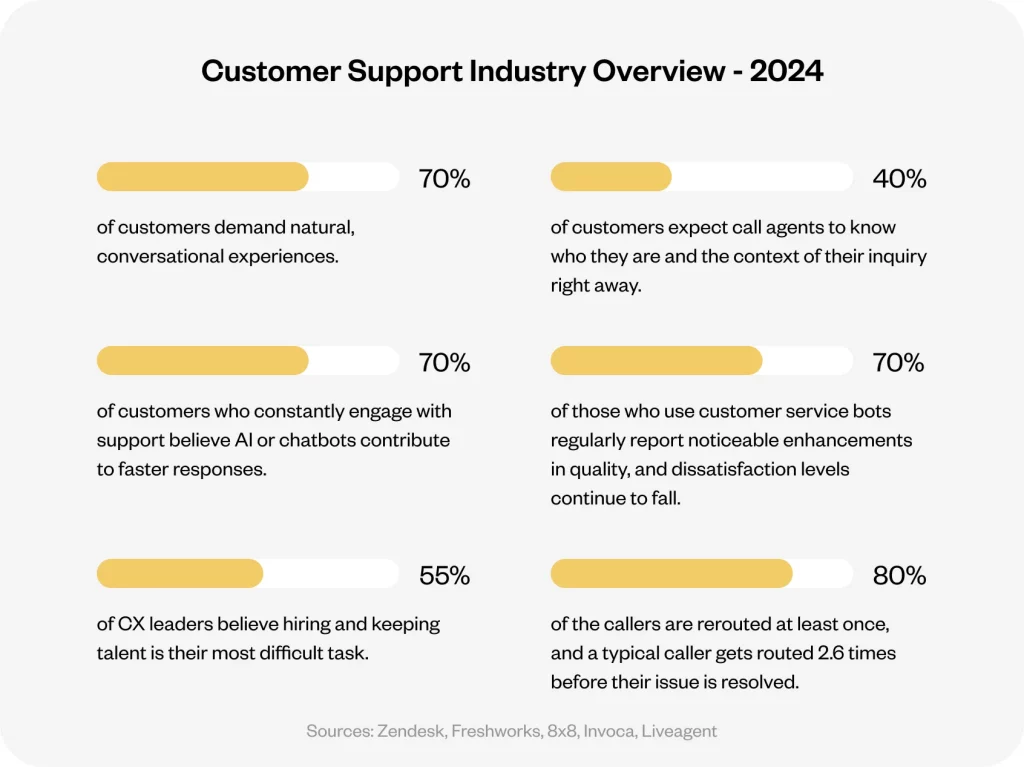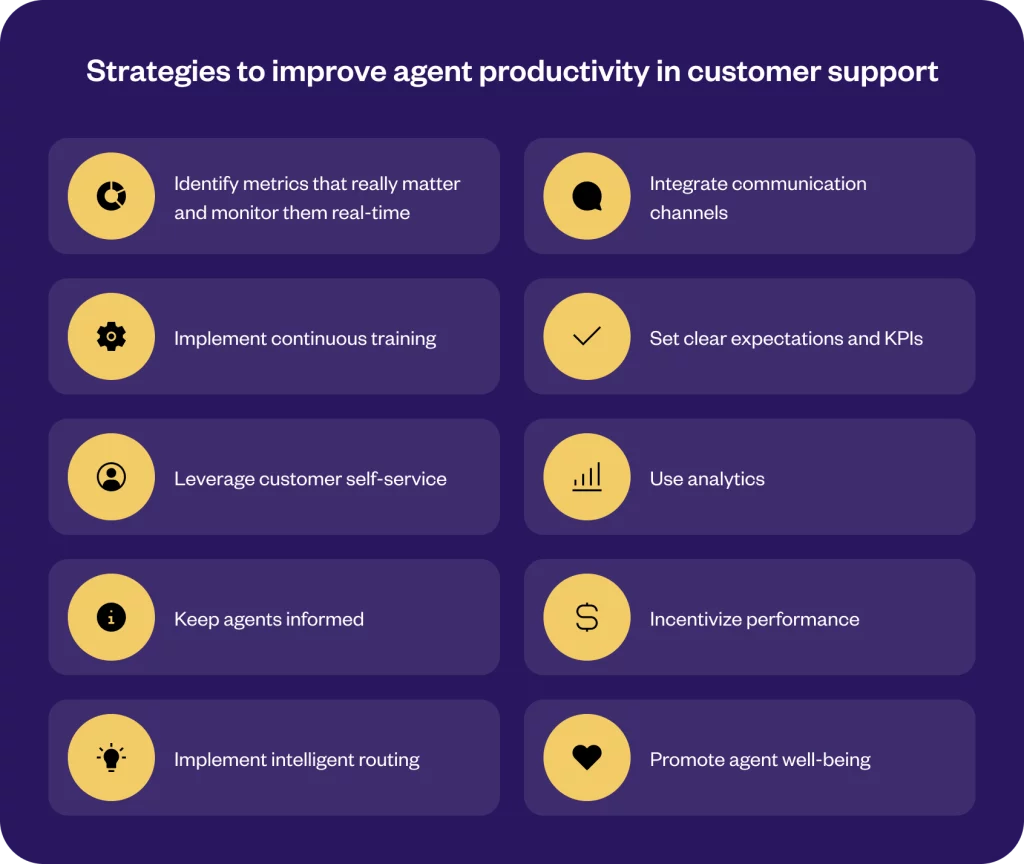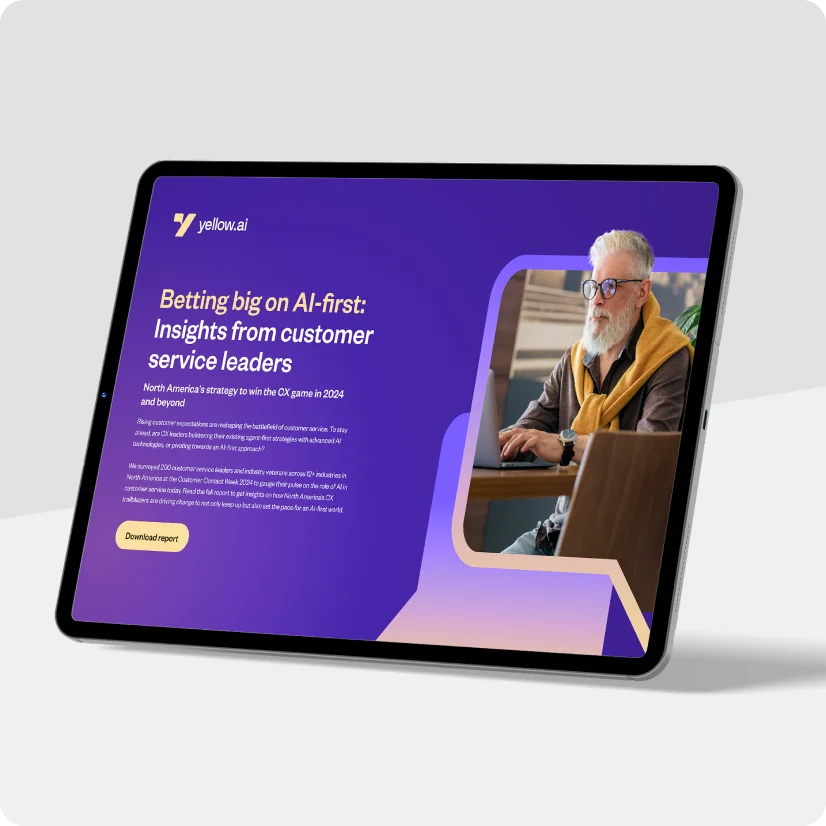Common summary:
In today’s customer service landscape, where customer expectations are sky-high and patience thin, enhancing agent productivity of your support function is crucial for business success. In 2024, there is already a massive shift in the customer service industry across the sector. According to the Five9 Customer Service Index 2022, which surveyed consumers in seven European and North American nations, 65% of leaders have shifted their attention to measures measuring agent productivity and retention. The foray of artificial intelligence, virtual reality and automation is redefining this sector.

Despite these advancements, many top-tier companies, perhaps including yours, grapple with challenges that curtail their support agents’ effectiveness. Factors ranging from outdated systems to a pervasive sense of demotivation among staff can cripple productivity, leading to customer churn, revenue losses, and alarmingly high attrition rates. Your customers might not see or care about these internal battles, but their impact on the business is undeniable and far-reaching.
The challenge might appear like a herculean task, but the solution lies in 10 proven strategies that can improve your agent productivity. This blog is your guide, helping you to navigate every challenge with ease. You will also explore the exact meaning of agent productivity and how collaborating with leading platforms like Yellow.ai for customer service automation can solve your problems.
Related must-reads:
- AI Agent Assist – Elevating customer support efficiency
- AI agents: types, benefits, and examples
- Utterance suggestions for effective dynamic AI agent intent generation
- AI automated workflows for customer support agents
What is agent productivity?
Agent productivity in a customer service context refers to the efficiency and effectiveness with which support agents handle customer interactions. It’s not just about the speed of response or the number of calls an agent can handle in a day; it’s about the quality of those interactions and the ability to resolve issues satisfactorily. As technology evolves, so too does the benchmark for what counts as productive behavior in call and contact centers. Back in the day, an agent’s “productivity” was directly proportional to just the number of calls or interactions they are able to handle in a given workday. Today, high productivity is marked by quick yet accurate resolutions that leave customers feeling valued and supported. This metric becomes particularly important in an era where customer service is a key differentiator for businesses.
However, measuring agent productivity isn’t straightforward. It involves a blend of quantitative data such as call resolution rates, average handling time, and first contact resolution rates, and qualitative measures like customer satisfaction scores and feedback. Each metric offers a glimpse into how well agents are performing and, when combined, they provide a comprehensive picture of overall efficiency. In the evolving landscape of customer service, where digital interactions are becoming as common as voice calls, these productivity metrics need to adapt. They must now capture the nuances of digital engagements, reflecting how agents manage multi-channel communications, from live chats, to email, to social media interactions.
Strategies to improve agent productivity in customer support
Here is a list of 10 effective tips that can work as panacea to boost your agent productivity and create new milestones in customer service. Scan through them and chalk-out a strategy that works best for you.

1. Identify metrics that really matter and monitor them real-time
To enhance agent productivity effectively, it’s crucial to differentiate between metrics that genuinely reflect performance and those that are merely “vanity metrics.” that simply look impressive on reports but offer little insight into how to improve or impact customer experiences meaningfully.
Comparing vanity and meaningful metrics:
Vanity Metric: Number of Calls Handled Per Agent
Why it’s not useful: Simply tracking the number of calls each agent handles can be misleading. High call volumes don’t necessarily equate to effective service or satisfied customers.
Meaningful metric: First Contact Resolution (FCR)
Why it matters: FCR measures the percentage of calls resolved on the first interaction. A high FCR indicates that issues are being resolved efficiently, contributing to higher customer satisfaction without requiring follow-up calls.
Vanity Metric: Average Call Duration
Why it’s not useful: A shorter call duration might seem to indicate efficiency, but it can also mean that issues are not being thoroughly resolved, potentially leading to repeat calls.
Actionable Metric: Customer Satisfaction (CSAT)
Why it matters: CSAT scores provide direct feedback from customers about their satisfaction with each interaction. This metric helps ensure that quality isn’t sacrificed for speed.
Vanity Metric: Total Tickets Closed
Why it’s not useful: Closing many tickets might look productive but doesn’t always mean customer issues are properly resolved.
Actionable Metric: Net Promoter Score (NPS)
Why it matters: Reflects customer intent to recommend your service based on their support experience, indicating true performance and customer loyalty.
Vanity Metric: Service Level (SLA Compliance)
Why it’s not useful: Meeting SLA targets is important, but focusing solely on compliance can lead to a checkbox mentality where quality of interaction is overlooked.
Actionable Metric: Customer Effort Score (CES)Why it matters: Evaluates how easy it is for customers to get their issues resolved, which is a direct predictor of customer loyalty and repeat business.
2. Integrate communication channels
Integrating all the channels that your customers use such as phone, email, social media, and chat support into a unified platform significantly enhances agent productivity. This integration allows for the seamless handling of customer inquiries, streamlining interactions and cutting down response times. Moreover, incorporating advanced automation within this unified system ensures that many routine inquiries are resolved without the need for human intervention, allowing agents to focus on more complex issues.
Benefits of channel integration and automation
- Streamlined communication: All customer interactions, whether handled by bots or human agents, are accessible in one place, reducing the time spent navigating between different platforms.
- Increased efficiency: Automation handles routine inquiries, freeing up agents to deal with more specialized tasks. This leads to faster resolutions and enhances overall throughput.
- Enhanced customer experience: Customers receive quicker and more consistent responses. Automated responses are immediate, which greatly enhances satisfaction, especially for straightforward queries.
Common challenges and solutions
- Data silos: Integrating data across automated and human-handled interactions can be challenging. Ensure that your omnichannel software can seamlessly integrate with your CRM and other back-end systems to provide a unified customer view.
- Balancing automation and human touch: Finding the right balance between automated responses and human intervention is crucial. Use analytics to understand which types of inquiries are best handled by automation and which should be escalated to human agents.
- Consistency across channels: Maintaining consistent service quality across automated and human interactions across all channels can be challenging. Regular performance reviews and adjustments are necessary to ensure a uniform quality of service.
How to implement effective channel integration
- Choose a robust omnichannel platform: Opt for customer support software that supports extensive automation capabilities alongside traditional communication channels.
- Implement a unified agent dashboard: This dashboard should provide a comprehensive view of both automated interactions and those handled by agents, including complete customer history and previous issues.
- Leverage automated routing and tagging: Utilize features that automatically route inquiries to the appropriate resolution path—be it an automated response or a human agent—and tag conversations with relevant data to aid in quick resolution.
3. Implement continuous training
Businesses aiming to enhance customer support agents’ productivity need to implement continuous training. It assures that you can consistently deliver exceptional customer service. In contrast to 57% of underperformers, 88% of service decision-makers achieving outstanding performance are heavily spending on agent training. Regular training programs help agents stay updated about product and services knowledge and if there are any new features or upgrades. Besides this, the training should be around improving their communication skills, and problem-solving techniques. Such constant upscaling aids them to have the required tools to handle customer inquiries confidently and effectively.
Benefits
As the agents remain always updated with the knowledge, skills and tools they become more productive. 83% of top performers in customer service agents report receiving adequate training to execute their jobs successfully. The benefits of continuous training include augmented agent confidence, reduced errors, and enhanced customer satisfaction.
How to do it?
Integration of AI copilots: Utilize AI copilots within training systems to keep agents updated on new product features and services. These AI tools can provide real-time assistance and guidance, helping agents apply their learning directly during customer interactions.
Focused training on evolving products: Ensure that training sessions include comprehensive updates on new products, upgrades, or changes to existing offerings. This keeps agents aligned with the brand’s current portfolio and market strategy.
Peer-to-peer learning and knowledge sharing: Foster an environment of collaboration with tools that facilitate knowledge sharing and mentorship. This can include internal forums, chat groups, or regular virtual meet-ups where agents can discuss challenges and solutions.
4. Set clear expectations and KPIs
If you aim to boost your customer support agents’ productivity, you must establish clear expectations and key performance indicators (KPIs). Without a defined goal and expected results, your agents are left guessing what to do, which, in the long run, can have a huge impact on their performance and efficiency. Human psychology works better when the goal is set. Thus, define specific goals, performance metrics, and expected outcomes to equip the agents with a roadmap for success and clarity on what is required of them.
Benefits
By setting clear expectations and KPIs, businesses empower their support agents with improved focus, accountability and alignment their goals with organizational objectives. All these help the agents perform at their best, drive productivity and deliver exceptional customer service.
How to do it?
As a business with a customer service team, implement this strategy effectively by communicating expectations and KPIs clearly to agents and making sure they know what to do and how to do it. Meanwhile, following best practices like regularly reviewing progress against set KPIs and providing constructive feedback helps agents track their performance and make necessary adjustments. Conveying the sense of inclusion by involving agents in the goal-setting process and allowing for input can increase engagement and motivation.
5. Leverage customer self-service
Businesses must leverage customer self-service as an effective strategy to boost customer support agent productivity. Statistics reveal that 72% of clients want fast and relevant self-serve answers. If you are wondering why and how, here are the answers. As you offer a comprehensive self-service option such as an exhaustive knowledge base, customers can resolve several common issues independently. This results in reducing the need to connect with human agents, thus minimizing the workload and allowing them to concentrate on more complex queries.
Related read: Generative AI-powered self-service: The future of customer support
Benefits
Self-service options empower customers and, in most cases, lead to faster issue resolution, higher satisfaction, and enhanced business cost savings. As mentioned earlier, they also free human agents from attending to minor issues that can be self-served by the customer, like knowing the return policy or timing of the service availability, etc. Trend analysis and monitoring customer engagement with self-service content can also yield valuable insights regarding opportunities for targeted training and areas that require refinement.
How to do it?
To implement customer self-service, businesses can create a knowledge base and design it thoughtfully with frequently asked questions (FAQs) and guides. Besides these, the modern era gives the advantage of setting up online portals for account management and utilizing AI chatbots for real-time assistance. By eliminating the requirement for immediate support from live agents, these tools aid customers in locating information and resolving issues expeditiously. To ensure that self-service is efficient and user-centric, furnish exhaustive, current, and pertinent information. When complicated problems arise, integrating self-service with other support channels, such as chatbots and digital agents, can enable agents to assist consumers more efficiently.
6. Use analytics
Data analytics aren’t fancy phrases; when used strategically, they bring a host of positive outcomes, including enhancing the productivity of customer service agents. They enable businesses to recognize and categorize trends, optimize workflows, and customize interactions. Together, these measures help to enhance agent efficiency and customer satisfaction.
Benefits
A few of the advantages of using analytics are enhanced decision-making capabilities, streamlined operational procedures, and customized consumer experiences. By examining customer data, organizations can acquire valuable knowledge regarding prevalent challenges, consumer inclinations, and barriers to operations, thereby enabling focused alterations.
How to do it?
Investments in analytics tools that monitor and assess consumer feedback, performance metrics, and interactions are what organizations can use to achieve this objective. Through the utilization of these interpretations, organizations can optimize support procedures, deliver customized assistance, and ultimately enhance agent efficiency and client contentment.
7. Keep agents informed
Imagine working as a customer support agent in an organization where you aren’t aware of half of the information related to the brand, its products and services. Will you be able to do your work efficiently? The answer is a clear no! Thus, as a business, it is your duty to keep your customer support agents informed about policies, products, and procedures. Regular updates ensure agents have the latest information, enabling them to respond accurately and efficiently to customer inquiries. This leads to higher customer contentment and reduced resolution times.
Benefits
A simple step like keeping the agents informed empowers them to handle queries effectively, boosting confidence and productivity. When workforce efficiency increases, it also ensures exceptional customer service.
How to do it?
Organizations may put this into action by setting up a system of frequent meetings, training sessions, or newsletters to disseminate information. Giving agents access to internal knowledge bases or frequently asked questions may also help them stay updated and answer issues faster.
8. Incentivize performance
Rewards and awards also fuel the drive to work better and excel. Your customer support agents will be zealous to perform their best when you incentivize their performance. Offering accolades, recognition, or bonuses for exceptional achievements can motivate them to outshine, drive productivity, and foster a culture of excellence within the support team.
Benefits
By implementing performance recognition and reward systems, organizations can encourage agents to exceed expectations in their respective positions, resulting in heightened job satisfaction, morale, and customer service quality. Enhanced employee engagement, decreased employee attrition, and a more positive work environment are a few additional advantages.
How to do it?
Businesses can effectively implement this strategy by establishing transparent performance metrics, developing a reward system linked to key objectives, and routinely recognizing and celebrating top performers. Enhancing motivation and productivity among support agents can be achieved by offering a combination of monetary and non-monetary incentives customized to individual preferences.
9. Implement intelligent routing
Implementing intelligent routing is an effective strategy to boost customer support agent productivity. It is a must for businesses to ensure that they handle each interaction efficiently and effectively. Harnessing the power of technology, they can use AI-powered algorithms to assign customer inquiries to the most suitable agent automatically. This routing can be based on parameters such as expertise, skills, language, and availability. In contrast to 39% of underperformers, 69% of top-performing service agents seek opportunities to use AI.
Benefits
By continuously monitoring and adjusting routing strategies and executing intelligent routing, businesses can ensure that their agents are matched with the right inquiries, leading to improved productivity and customer satisfaction. As it routes the interaction to the most suitable agents, it also lessens workloads. This approach minimizes the time spent on manual routing and increases the likelihood of first-contact resolution, thus achieving enhanced customer gratification.
How to do it?
Businesses can take the basic step, which starts by analyzing their customer support data. The goal is to recognize patterns and trends in inquiries; it can be common issues, customer demographics, and factors like channel preferences. On the basis of the analysis report and essential information, they can develop a routing strategy that prioritizes specific skills, languages, or expertise for each type of inquiry. Today, several AI-powered tools come in handy here to analyze customer interactions in real-time, recognizing and sensing sentiments and intent to optimize routing decisions further.
10. Promote agent well-being
Promoting agent well-being isn’t merely a step towards their good health. It is an effective measure to improve the productivity and job performance of customer support agents. Create a supportive work environment which prioritizes mental and physical health. Businesses can take This highly recommended step to help agents reduce stress, avoid burnout, and maintain high-performance levels, resulting in improved customer satisfaction and reduced turnover rates.
Benefits
This approach offers an array of perks, starting from boosting productivity, enhanced customer satisfaction and reduced turnover rates. Better well-being equates to better productivity.
How to do it?
Try to implement practices and policies that support a perfect work-life balance. To achieve it and promote agent well-being, businesses can think of initiatives such as flexible scheduling, regular breaks, healthy time off, and giving proper access to mental health resources. Likewise, invest in ergonomic workstations. Always keep the facilities in place for physical activity, like an in-house gym or an indoor sports zone. Building a supportive and inclusive work ecosystem that appreciates diversity, celebrates successes, and promotes candid feedback and ideas goes a long way. By fostering a supportive and collaborative environment, businesses can help agents feel valued, engaged, and motivated to perform at their best.
How can Yellow.ai help businesses improve their customer service agents’ productivity?
By now, you have learned several proven tips and how to implement them to improve your customer support agents’ productivity. Nevertheless, a few measures might appear overwhelming. This is where you can get the expert support of Yellow.ai, which has proven its efficacy in helping several enterprises worldwide achieve such goals thanks to its advanced customer service automation solutions. With its cutting-edge AI-automated tools and capabilities, esteemed brands like Pelago, Hyundai, Lion Parcel and more have embraced seamless automation and are witnessing incredible results in their human agents’ enhanced productivity and heightened customer satisfaction. From using analytics, implementing intelligent call routing, giving the workforce regular breaks, integrating channels, and harnessing customer self-service options to promoting agents’ well-being, you can plan and execute strategies to augment the performance and efficiency of your human agents.
AI-powered automation
Yellow.ai deploys AI-driven chatbots that handle routine inquiries, allowing human agents to focus on more complex and nuanced customer issues. This reduces the overall volume of queries agents must address manually, boosting their productivity.
Real-time assistance
The platform provides agents with real-time suggestions and information retrieval during customer interactions, minimizing the time spent searching for data and solutions. This feature ensures that agents can provide quick and accurate responses, enhancing both efficiency and customer satisfaction.
Omnichannel support
With Yellow.ai, all customer communication channels are integrated into a single platform. This unified approach prevents agents from switching between different systems and interfaces, streamlining their workflow and significantly reducing response times.
Analytics and insights
The platform offers detailed analytics on agent performance and customer interactions, allowing managers to identify bottlenecks, track improvements, and understand areas where additional training might be needed. This data-driven approach helps continuously optimize processes and agent performance.
Training and onboarding
Yellow.ai facilitates quicker agent onboarding and continuous training through its AI-driven simulations and training modules. These tools keep agents up to date with the latest procedures and protocols, ensuring they are well-prepared to meet customer needs effectively.
Key takeaways
In today’s digital-dominant business world, keeping up with customers’ expectations while serving them can feel formidable at times. It is natural for customer service agents to experience a depleting efficiency in their performance. But the good news is that the rapidly evolving technology is here as a boon. Just be open as an early adopter of it and introduce and integrate it into your customer service not just to boost agents’ productivity but also to improve and exceed customer satisfaction. This blog highlighted how advanced and futuristic technological innovations and tools like data analysis, AI, virtual assistants and automation can work in harmony with human agents and help them improve performance, achieve work-life balance, solve problems like a pro and win hearts with excellent customer service.






















